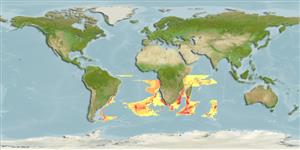Environment: milieu / climate zone / depth range / distribution range
Ekologi
laut batipelagis; kisaran kedalaman 850 - 1480 m (Ref. 2800). Deep-water
Southeast Atlantic and Southwest Indian Ocean: Table Bay, South Africa to Mozambique.
Size / Weight / umur
Maturity: Lm ? range ? - ? cm
Max length : 46.0 cm TL jantan/; (Ref. 2800)
deskripsi pendek
Kunci identifiaksi (pengenalan) | Morfologi | Morfometrik
Duri punggung (Keseluruhan (total)) : 2; duri punggung lunak (Keseluruhan (total)) : 169 - 170; Duri dubur: 0; Sirip dubur lunak: 150. Flesh-colored; blackish over gill covers; fins dusky to black (Ref. 2800).
Life cycle and mating behavior
Kematangan | Reproduksi, perkembang biakan | Pemijahan | telur-telur | Fecundity | Larva
Iwamoto, T. and E. Anderson, 1994. Review of the grenadiers (Teleostei: Gadiformes) of southern Africa, with descriptions of four new species. Ichthyol. Bull. J.L.B. Smith Inst. Ichthyol. (61):1-28. (Ref. 11953)
Status IUCN Red List (Ref. 130435: Version 2024-1)
ancaman kepada manusia
Harmless
penggunaan manusia
Alat, peralatan
laporan khas
muat turun XML
Sumber internet
Estimates based on models
Preferred temperature (Ref.
123201): 2.1 - 6.9, mean 4.7 °C (based on 92 cells).
Phylogenetic diversity index (Ref.
82804): PD
50 = 0.5001 [Uniqueness, from 0.5 = low to 2.0 = high].
Bayesian length-weight: a=0.00372 (0.00141 - 0.00976), b=3.11 (2.88 - 3.34), in cm total length, based on LWR estimates for this (Sub)family-body shape (Ref.
93245).
Trophic level (Ref.
69278): 3.1 ±0.1 se; based on size and trophs of closest relatives
Fishing Vulnerability (Ref.
59153): Moderate vulnerability (36 of 100).
